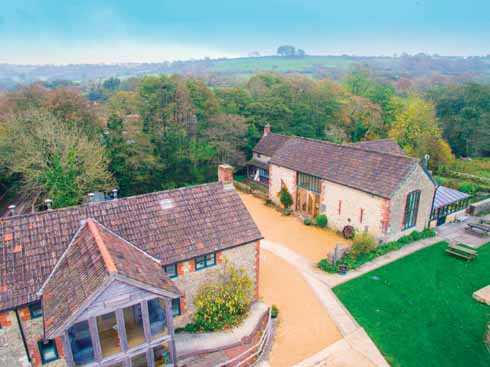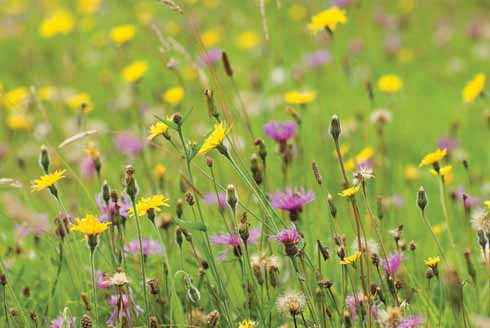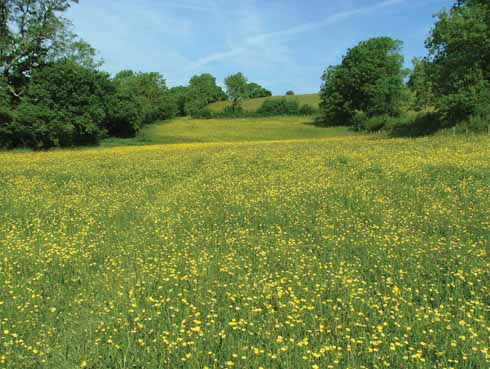The farm that time forgot
Jim White tells the 30-year story of DWT’s involvement with Kingcombe and its wonderful flower-rich fields
Published in June ’17
The whole of Kingcombe Farm, some 640 acres straddling the valley of the River Hooke west of Toller Porcorum, came on the market in 1985, after the death of the owner, Arthur Walbridge, at the age of 90. The Kingcombe hamlet was striking in those days, as only two of the former dwellings were still habitable. It looked and felt like a forgotten, secret place even amongst west Dorset’s array of hidden gems. Sadly, despite frantic efforts to promote its outstanding interest as a very rare example of extensive unspoiled grassland (along with wonderful billowing hedges, copses, sunken lanes and a stretch of the River Hooke), none of the conservation bodies was able to rise to the challenge of purchase at that stage.
The land was bought privately and then divided into fifteen lots, many with a ruin just ripe for re-building. The farm was put on the market again in 1987 and advertised nationally for sale at auction. For those passionate about nature conservation, the future of those wonderful flower-rich fields seemed bleak indeed.

The state of disrepair into which the buildings had fallen when the DWT bought the farm (Debbie Billen)
Despite most of the land having been notified as a Site of Special Scientific Interest, there was then no financial support for positive management. If funds were not raised to buy and manage at least some of the farm, the unique character of this special place could be lost forever: grasslands drained and improved, and hedges and copses tamed. The future for the unusually extensive flower-rich pastures seemed hopeless. Lady’s mantle, lousewort, petty whin, pepper-saxifrage, sneezewort, corky-fruited water-dropwort and many other beautiful, intriguing and often uncommon flowers, grasses and sedges might become just memories. Their context, in pastures that had not seen modern fertilisers, all encompassed within ancient hedges based on massive, centuries-old stools and festooned with lichens and mosses, would also be at severe risk.
The full story of how the challenge to save Kingcombe and secure its future was met would fill far more space than is available here, but thanks to a brave effort by several people, a campaign was launched at the eleventh hour that rallied many supporters. A piece on the BBC’s Today programme and a superb article in the Telegraph spread the news far more widely and, against all expectations, donations to save Kingcombe flowed in. Dorset Wildlife Trust was able to go to the auction and purchase several of the ‘lots’, while other generous and like-minded people, keen to maintain the ethos of the site, secured further key parts, significantly including some with buildings or ruins.
The management of the farm before the sale had been extensive grazing by a suckler herd and some sheep that ranged across the whole site; few of the internal hedges were stock-proof then. Some of the fields were also traditionally laid up for a hay crop in summer. For DWT, managing a farm would be a new venture and was rare for any Wildlife Trust at the time. The land, suddenly new to DWT, had to be understood alongside discovering the rich wildlife living there. Big decisions had to be taken and funding found. A programme of hedge laying and fencing was started, water for cattle supplied and suitable livestock acquired. The only external funding at the time was that available for ‘historic landscapes’, but happily the array of Kingcombe’s ancient hedges helped gain an initial grant.
As well as the great range of attractive and often scarce flowers known from Kingcombe’s grasslands from the start, we now know much more of the importance and indeed heritage significance of the site. For instance, it is of national importance for waxcap fungi, bright jewels of the turf in autumn; it has a thriving population of hazel dormice in the hedges and woods; many invertebrates flourish; and rare marsh fritillary butterflies have returned, feeding on devil’s-bit both there and at Powerstock Common. The Kingcombe Centre, originally established from ruined barns and operated privately, is now owned by DWT and its exciting programme beautifully complements the surrounding outstanding nature reserve. Comfortable accommodation and food are features of the courses, from day events ranging from painting and willow-weaving to longer stays exploring the local landscape and wildlife.
Over the 30 years in DWT management, other land, much part of the original farm, has come into DWT’s hands, some by purchase and some by generous gift. A further 117 acres in seven parcels have been added, consolidating the historic purchase. Today the cattle are housed inside in winter, in purpose-built barns, and fed on superb hay made from Kingcombe’s meadows. The breed of cattle best adapted for the job has been resolved after several trials, as not only have they to be suitable for not especially productive pasture, they need to be as commercially viable as possible and to be acceptable on a site that is fully open to visitors.
With a reservoir of resources and growing experience, Kingcombe has also come to be the farming hub for other DWT nature reserves in the area that also need a supply of grazing animals and access to suitable machinery. The experience in managing a farm for wildlife and production are important dual outcomes for DWT, both to demonstrate to visitors to the Kingcombe Centre and nature reserve, and more widely in the living landscapes of west Dorset and beyond. It has also enabled DWT to offer advice to others who may be keen to adopt similar ideas, albeit on a smaller scale, whether as part of commercial farming or purely for interest. Green hay, rich in seed from the variety of Kingcombe’s wild plants so well adapted to this area, has been provided to several people wanting to restore an element of flower-rich turf on their own land.

Members of the Wallbridge family (Leslie, Michael and Pat) building a haystack during the late 1940s. (Black and white photos courtesy of Mr & Mrs R Bere, Mrs P Denhy and Mrs J Knowles)
What we see now as fascinating aspects of nature must have been tough challenges indeed for Kingcombe’s farmers in the past, before the advantages of modern machinery and chemicals. The hard conditions must have bruised but also moulded and shaped the character of those who have preceded us: unforgiving heavy wet clays in winter rains and frosts; racing against the clock on sultry summer days to make sufficient hay before the next downpour; and all the time the urgent pressure to make enough for a living. The stubborn land must have etched itself deeply into its past occupants. And in a way the same need for determination and a full empathy with the land applies still, even though our objectives and our constraints are different. Rather than farming just for our own survival, we are striving to maintain outstanding wildlife, conserving a heritage asset of national importance, while keeping in total harmony with the stunning landscape. There remain the constant challenges of securing adequate funding, especially in such uncertain times, so the Trust, as far as possible, needs to balance running a viable enterprise with the priority of maintaining great wildlife.

Poorer members of the community lived in small houses with large plots of land for growing vegetables, keeping poultry and perhaps a pig. Although these cottages have disappeared, their locations are mapped and can be seen from the lanes. This photograph shows Mrs Cleall in 1881. Her cottage was at the bottom of Mount Pleasant Lane. The bend in Kingcombe Lane is known locally as Cleall’s corner.
A hundred years after it was bought at auction by the Wallbridges, and on the thirtieth anniversary of Kingcombe’s acquisition by Dorset Wildlife Trust, this is an ideal opportunity to recall the history of this special place, not least those desperate times in 1987, and to rejoice that so much of the ‘farm that time forgot’ was saved.
- The author would like to thank Mr & Mrs R Bere, Mrs P Denty and Mrs J Knowles for their permission to use the black and white pictures appearing with this piece.





